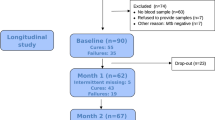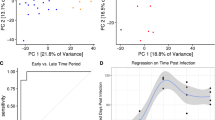Abstract
Tuberculosis (TB) still poses a profound burden on global health, owing to significant morbidity and mortality worldwide. Although a fully functional immune system is essential for the control of Mycobacterium tuberculosis infection, the underlying mechanisms and reasons for failure in part of the infected population remain enigmatic. Here, whole-blood microarray gene expression analyses were performed in TB patients and in latently as well as uninfected healthy controls to define biomarkers predictive of susceptibility and resistance. Fc gamma receptor 1B (FCGRIB)was identified as the most differentially expressed gene, and, in combination with four other markers, produced a high degree of accuracy in discriminating TB patients and latently infected donors. We determined differentially expressed genes unique for active disease and identified profiles that correlated with susceptibility and resistance to TB. Elevated expression of innate immune-related genes in active TB and higher expression of particular gene clusters involved in apoptosis and natural killer cell activity in latently infected donors are likely to be the major distinctive factors determining failure or success in controlling M. tuberculosis infection. The gene expression profiles defined in this study provide valuable clues for better understanding of progression from latent infection to active disease and pave the way for defining predictive correlates of protection in TB.
This is a preview of subscription content, access via your institution
Access options
Subscribe to this journal
Receive 6 digital issues and online access to articles
$119.00 per year
only $19.83 per issue
Buy this article
- Purchase on Springer Link
- Instant access to full article PDF
Prices may be subject to local taxes which are calculated during checkout



Similar content being viewed by others
References
Smith NH, Hewinson RG, Kremer K, Brosch R, Gordon SV . Myths and misconceptions: the origin and evolution of Mycobacterium tuberculosis. Nat Rev Microbiol 2009; 7: 537–544.
Chan J, Flynn J . The immunological aspects of latency in tuberculosis. Clin Immunol 2004; 110: 2–12.
Kaufmann SH, Cole ST, Mizrahi V, Rubin E, Nathan C . Mycobacterium tuberculosis and the host response. J Exp Med 2005; 201: 1693–1697.
World Health Organization Annual Report 2009. Global Tuberculosis Control—Epidemiology, Strategy, Financing. WHO: Geneva, Switzerland, 2009.
Comas I, Gagneux S . The past and future of tuberculosis research. PLoS Pathog 2009; 5: e1000600.
Chaisson RE, Harrington M . How research can help control tuberculosis. Int J Tuberc Lung Dis 2009; 13: 558–568.
Marais BJ, Raviglione M, Donald PR, Harries AD, Kritski AL, Graham SM et al. Scale up services and research priorities for TB diagnosis, management and control. Call to Action. Lancet 2010; 375: 2179–2191.
Flynn FL, Chan J . Immunology of tuberculosis. Annu Rev Immunol 2001; 19: 93–129.
Ulrichs T, Kaufmann SH . New insights into the function of granulomas in human tuberculosis. J Pathol 2006; 208: 261–269.
Dorhoi A, Kaufmann SH . Fine-tuning of T cell responses during infection. Curr Opin Immunol 2009; 21: 367–377.
Korbel DS, Schneider BE, Schaible UE . Innate immunity in tuberculosis: myths and truth. Microb Infect 2008; 10: 995–1004.
Russell DG, Cardona P-J, Kim M-J, Allain S, Altare F . Foamy macrophages and the progression of the human tuberculosis granuloma. Nat Immunol 2009; 10: 943–948.
Quesniaux V, Fremond C, Jacobs M, Parida S, Nicolle D, Yeremeev V et al. Toll-like receptor pathways in the immune responses to mycobacteria. Microbes Infect 2004; 6: 946–959.
Kaufmann SH . Tuberculosis: deadly combination. Nature 2008; 15: 295–296.
Brill KJ, Li Q, Larkin R, Canaday DH, Kaplan DR, Boom WH et al. Human natural killer cells mediate killing of intracellular Mycobacterium tuberculosis H37Rv via granule-independent mechanisms. Infect Immun 2001; 69: 1755–1765.
World Health Organization. The Stop TB Strategy, Building on and Enhancing DOTS to Meet the TB-Related Millennium Development Goals. WHO: Geneva, 2006 (WHO/HTM/TB/2006.368).
Jacobsen M, Repsilber D, Gutschmidt A, Neher A, Feldmann K, Mollenkopf HJ et al. Candidate biomarkers for discrimination between infection and disease caused by Mycobacterium tuberculosis. J Mol Med 2007; 85: 613–621.
Dennis Jr G, Sherman BT, Hosack DA, Yang J, Gao W, Lane HC et al. DAVID: Database for annotation, visualization, and integrated discovery. Genome Biol 2003; 4: P3.
Huang DW, Sherman BT, Lempicki RA . Systematic and integrative analysis of large gene lists using DAVID Bioinformatics Resources. Nature Protoc 2009; 4: 44–57.
Brikos C, O’Neill LA . Signalling of toll-like receptors. Handb Exp Pharmacol 2008; 183: 21–50.
Takeuchi O, Akira S . Pattern recognition receptors and inflammation. Cell 2010; 140: 805–820.
Gaucher D, Therrien R, Kettaf N, Angermann BR, Boucher G, Filali-Mouhim A et al. Yellow fever vaccine induces integrated multilineage and polyfunctional immune responses. J Exp Med 2008; 205: 3119–3131.
Jacobsen M, Mattow J, Repsilber D, Kaufmann SH . Novel strategies to identify biomarkers in tuberculosis. Biol Chem 2008; 389: 487–495.
Parida SK, Kaufmann SH . The quest for biomarkers in tuberculosis. Drug Discov Today 2010; 15: 148–157.
Mistry R, Cliff JM, Clayton CL, Beyers N, Mohamed YS, Wilson PA et al. Gene-expression patterns in whole blood identify subjects at risk for recurrent tuberculosis. J Infect Dis 2007; 195: 357–365.
Glatman-Freedman A, Casadevall A . Serum therapy for tuberculosis revisited: reappraisal of the role of antibody-mediated immunity against Mycobacterium tuberculosis. Clin Microbiol Rev 1998; 11: 514–532.
Abebe F, Bjune G . The protective role of antibody responses during Mycobacterium tuberculosis infection. Clin Exp Immunol 2009; 157: 235–243.
Nimmerjahn F, Ravetch JV . Fcγ receptors as regulators of immune responses. Nat Rev Immunol 2008; 8: 34–47.
Gentleman RC, Carey VJ, Bates DM, Bolstad B, Dettling M, Dudoit S et al. Bioconductor: open software development for computational biology and bioinformatics. Genome Biol 2004; 5: R80.
Smyth GK, Michaud J, Scott HS . Use of within-array replicate spots for assessing differential expression in microarray experiments. Bioinformatics 2005; 21: 2067–2075.
Ritchie ME, Silver J, Oshlack A, Holmes M, Diyagama D, Holloway A et al. A comparison of background correction methods for two-colour microarrays. Bioinformatics 2007; 23: 2700–2707.
Smyth GK, Speed T . Normalization of cDNA microarray data. Methods 2003; 31: 265–273.
Efron B, Tibshirani R . Empirical Bayes methods and false discovery rates for microarrays. Genet Epidemiol 2002; 23: 70–86.
Liaw A, Wiener M . Classification and regression by randomforest. R News 2002; 2: 18–22.
Acknowledgements
We thank ML Grossman for thoroughly revising the paper, J Weiner for biostatistical support and the Microarray Core Facility unit at the Max Planck Institute for Infection Biology in Berlin for sample processing. This study was funded by Grant number 37772 from the Bill & Melinda Gates Foundation through the Grand Challenges in Global Health Initiative, to all authors except DR
Author information
Authors and Affiliations
Corresponding authors
Ethics declarations
Competing interests
The authors declare no conflict of interest.
Additional information
Supplementary Information accompanies the paper on Genes and Immunity website
Supplementary information
Rights and permissions
About this article
Cite this article
Maertzdorf, J., Repsilber, D., Parida, S. et al. Human gene expression profiles of susceptibility and resistance in tuberculosis. Genes Immun 12, 15–22 (2011). https://doi.org/10.1038/gene.2010.51
Received:
Revised:
Accepted:
Published:
Issue Date:
DOI: https://doi.org/10.1038/gene.2010.51
Keywords
This article is cited by
-
Genetic epidemiology of resistance to M. tuberculosis Infection: importance of study design and recent findings
Genes & Immunity (2023)
-
Identification of immune biomarkers in recent active pulmonary tuberculosis
Scientific Reports (2023)
-
The relationship between previous pulmonary tuberculosis and risk of lung cancer in the future
Infectious Agents and Cancer (2022)
-
Exploring key molecular signatures of immune responses and pathways associated with tuberculosis in comorbid diabetes mellitus: a systems biology approach
Beni-Suef University Journal of Basic and Applied Sciences (2022)
-
What genes are differentially expressed in individuals with schizophrenia? A systematic review
Molecular Psychiatry (2022)



